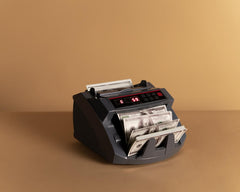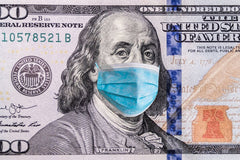Your cart is currently empty.

- Aug, 21 , 20
- 0 comments
Coin Shortage and what it May Lead to
The term “coin shortage” is being used with increasing frequency, fueling worries, and conspiracy theories that the United States might be running out of coins or be on the verge of becoming a cashless society. The country is undoubtedly facing a lack of coins in circulation, however, there is no reason to panic. This article will examine what has caused the coin shortage, why this is no cause for alarm, and the role that coins play in our lives and the running of a business, particularly small ones.
Enhance your cash management with our innovative bill counting machine. It reduces staff time dedicated to cash-related tasks, streamlines workflows, improves precision and dependability in financial operations, and enhances overall performance and security.
Coin usage in daily life
America has four denominations of US currency coins in circulation today - penny, nickel, dime, and quarter. These coins are produced by the United States Mint for everyday purchases. In recent years, an increasing number of Americans have started to move towards making cashless payments. However, there is still a sizeable number of people who do not have a bank account and still rely on cash to make payments. There is also a growing number of people who have bad credit and because of this are not able to make payments using credit cards. A recent survey conducted by The Federal Deposit Insurance Corporation (FDIC) has revealed that 26.9% of American households are either unbanked or underbanked. Those with an annual household income of less than $25 000 use cash in 43% of the transactions. These are the people who are being most disadvantaged by the current coin shortage and will be marginalized if the vision of a cashless society is ever realized.
Coin Shortage or Circulation Disruption?
Experts have agreed that the lack of coins is not a shortage, but rather a disruption that has affected the number of US coins in circulation. This disruption has been caused by several factors :
-
COVID-19 Pandemic - Stay-at-home orders issued by a variety of states have resulted in businesses that largely take coins, such as car washes, laundromats and vending machines having to cease operations until it is safe to reopen. Businesses such as these play a key role in getting coins to banks, after which they are redistributed back into the economy. The temporary closing down of these businesses has resulted in a low speed of circulation, whereby the number of coins in circulation is not sufficient to meet the demand. Coins have not disappeared, but are rather sitting in wallets and jars, waiting to be used once businesses can resume their normal operations. The US Mint revealed that 83% of new coins in circulation come from third-party processors and retail activity.
-
Lowered production by the United States Mint - The pandemic has caused the Mint to scale down its production. To protect its employees and adhere to social distancing guidelines, the Mint will likely slow down its coin production over the next 12 to 18 months. Gold and silver coins also will not be produced during this time. In a landmark move, the Mint is requesting that dealers provide 10-day and 90-day forecasts stating their demand, in order to prioritize the production of certain coins over others.
-
Pricey Pennies - US currency coins are known for being costly to produce. A penny costs 2 cents to make, and in 2019, made up 60% of the coins produced by the Mint. Last year, $72 million were lost to making pennies. The cost of copper and nickel, the metals needed to produce nickels, have steadily risen due to an increase in demand of these metals for other products. Just like the penny, the cost of producing a nickel is more than its nominal value, costing taxpayers a pretty penny. In 2018, $85.4 million was spent on penny production and $33.5 million on nickel production. Because of their low value, pennies and nickels are often discarded and forgotten around the house, quickly exiting circulation.
Coins and businesses
Small businesses, particularly those that solely rely on cash payments, have been hardest hit by the coin shortage sweeping America. Many of these businesses have not yet adopted an electronic point of sale system and cannot ask customers to switch to card payments the way that major retailers can. The coin shortage has forced coin-heavy businesses, such as laundromats and car washes, to order coins from banks, which requires them to pay a fee to acquire the necessary amount of coins. This is yet another expense that cash-strapped small businesses cannot afford, but are having to take on, during the pandemic.
The effects of the coin shortage
What does coin a shortage do? Its effects have been well-documented by the media in the past few months. Certain sectors of the economy, such as the retail industry, still rely heavily on cash payments, and they, along with small businesses are the ones who have been impacted most severely. The National Grocers Association states that 45-60% of payments made at grocery and convenience stores are cash. Close to half of transactions that are ten dollars or less are also paid with cash. The inconvenience of the coin shortage is also passed onto customers who are now being asked to pay with cards or exact change, something they might not always have access to.

There are ways in which business owners can handle the coin shortage as they start to reopen and rebuild. These solutions may also mitigate the negative effects of possible disruptions in the future:
-
Incentivize paying with coins - discounts can be offered to customers who pay with coins.
-
Create an exchange system with other businesses - Coin-heavy businesses, such as those mentioned above, can create exchange programs with other businesses that might be in desperate need of coins. Such an exchange system occurred in Hoover, Alabama where a laundromat gave over a large number of coins to a grocery retailer in exchange for paper money.
-
Consider implementing an electronic point of sale system - Businesses that solely rely on traditional point of sale systems are now realizing how detrimental this can be. An advanced coin sorting machine, such as those available today, can complement the speed and efficiency of an electronic point of sale system. There will always be market disruptions, however, staying abreast of the latest technologies can be the difference between a business weathering a disruption, or being destroyed by it.
Conclusion
The current COVID-19 pandemic has created numerous casualties, the most unexpected being the coin shortage many are experiencing across the country. Sensationalist headlines have created the false impression that America is running out of coins. It is important to remember this is merely a disruption that will ease once normal economic activity can resume. It is still uncertain when this might be, as infection rates continue to rise and many states have reinstated their stay-at-home orders. This disruption has caught many businesses and consumers unaware, forcing the former to review and upgrade their current business models whilst the latter have to rethink their payment methods. The so-called “coin shortage” has shown that although disruptions are frightening at first, they also afford opportunities for reinvention and growth in their wake.
Search
Custom Menu
Recent Post
Archive
- April 2022
- September 2021
- August 2021
- July 2021
- March 2021
- February 2021









